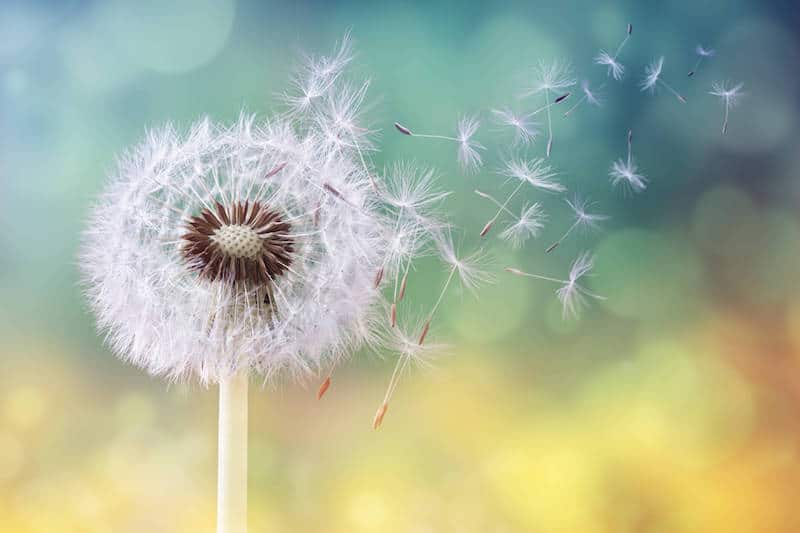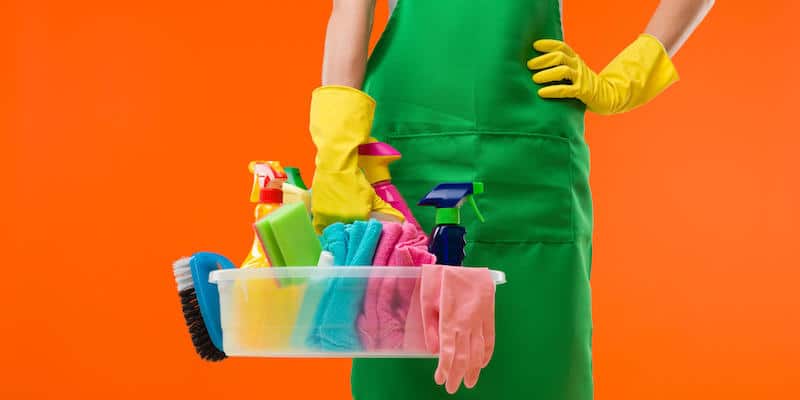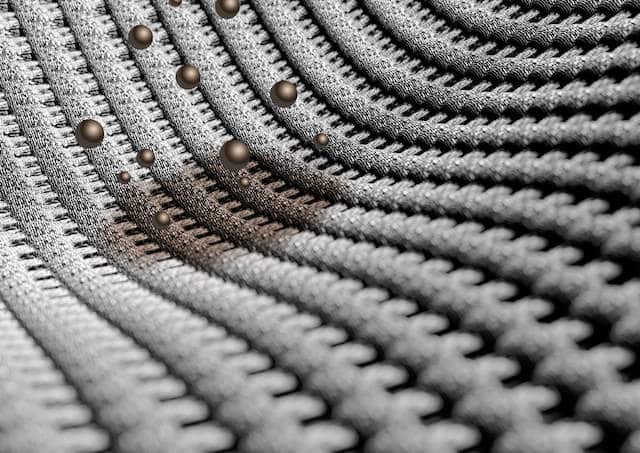Mold vs. mildew is one of the age-old debates when it comes to indoor mold growth: what’s the difference between the two, which one is harmful, and is that fungus you’re looking at actually mold or mildew? Knowing what you’re dealing with is great information to have, but understanding how to properly remove them is even more important.
The truth is, both mold and mildew should be handled the exact same way: immediately and correctly. The longer the mold is hanging out in your home, the greater the opportunity it will have to begin causing adverse health effects to you or your family.
So, here’s what you need to know about this fungus, regardless of whether you’re working with mold or mildew.

IS THAT MOLD OR MILDEW?
Contrary to popular belief, mildew is actually just a type of mold.¹’² It’s not its own entity separate from the “mold” umbrella. There are over 100,000 species of mold identified in the world so far, and they all fall under the umbrella of a type of fungus.³’⁴ With so many species of this fungus out there, mold can come in a range of textures, colors, and shapes.
This is a key distinction to remember in deciding whether or not you’re dealing with mold or mildew. The term “mildew” basically refers to mold that’s light in color and powdery in texture.
These mold colonies could be grey, white, or light green and grow in a flat format without much height, meaning they aren’t as fluffy and sponge-like as some other mold growth.
When referring to “mildew,” quite a few species can fall under this powdery mold category. One of the most frequently encountered is Aspergillus, which the CDC deems a “common mold.”⁵
MOLD OR MILDEW, IS IT ALIVE AND WHY IS IT IN YOUR HOUSE?
Mold and mildew have two parts: the particle and the living organism. All species of mold and mildew reproduce by creating microscopic spores, nonliving particles, that they release into the air. Once these spores land on a habitable surface, they’ll settle in, and begin growing root-like structures called hyphae. After this process, mold and mildew are now living organisms.

It’s not unlike how a dandelion puff produces those fluffy white seeds and releases them when a strong gust of wind blows through. If that dandelion seed lands on a habitable area, it will begin to grow and set down roots. Like a plant, spores need very little to survive and thrive. Give it food (it eats everything), a touch of oxygen, and a comfortable temperature, and that spore will be on the pathway to success.
The main component that’s often missing on surfaces, but crucial for growth, is moisture.⁶ If a surface, whether it be drywall, the dishwasher, a windowsill, the carpet, or the basement floor, is wet for at least 24 hours, this fungus among us will transition into the world of the living. Mildew, in particular, needs lots of moisture to survive and thrive, which is why it’s often found in the bathroom, on windowsills, or around doorframes.
Mold or mildew growth can occur in a home in the blink of an eye. Spores can fly right in through the front door, hitch a ride on a pet’s fur, or slide in an open window. Those lucky spores don’t typically cause a problem unless one of them lands on a surface with the right conditions for growth; then, a living mold colony will take hold and begin releasing more and more spores into your indoor air. That tanks the indoor air quality and increases the chances of another mold problem developing elsewhere in the home.
Some species of mold, like Aspergillus, a common mold or mildew, also release mycotoxins into the air when they feel threatened.⁷ While regulated in our food by the FDA, there are currently no government regulations stating acceptable limits for these toxins in our home.⁸ Combined with the spores floating around like confetti out of a confetti cannon, indoor mold growth can cause a contamination extravaganza inside of a home, and that can be a disaster for your health.
WHICH IS WORSE: MOLD OR MILDEW?
Since mildew is a type of mold, they both can cause health issues and need to be removed quickly and properly. As soon as that living mold or mildew puts down roots, it will begin releasing spores and potential toxins. Encountering a few of these particles throughout the day is impossible to avoid and typically doesn’t cause a problem. Your immune system descends and gets rid of it.
Breathing in a high volume of particles every time you take a breath inside your home, on the other hand, can cause your immune system to become depleted, overwhelmed, and/or malfunction. As exposure continues, that toxicity level inside the bodies of those in the home will continue to rise, opening the door for adverse health reactions to occur in full force. Aka, why indoor mold growth is a serious contamination no-no.
WHAT SHOULD YOU EXPECT?
When it comes to exactly what those health issues will be, that’s when things get squirrely. The truth is, everyone responds differently to mold exposure. Researchers are still attempting to determine exactly what this indoor contaminant does to our bodies, but factors such as genetics, immune system status, species of mold, length of exposure, and mycotoxin presence all play a role. ⁹’¹⁰’¹¹’¹²
What they do know is that individuals with pre-existing conditions and developing immune systems are at greater risk of developing symptoms faster and to a greater extent. So, while one person in a home may experience the occasional runny nose, another may develop a dozen symptoms from ongoing exposure.

SOME COMMON SYMPTOMS OF MOLD EXPOSURE INCLUDE:
- Coughing
- Rashes
- Digestive issues
- Chronic fatigue
- Fever
- Respiratory problems
- Hair loss
- Neurological issues
- Brain fog
Exposure can also work hand in hand with other autoimmune conditions such as Lyme disease and Candida because of the massive overload on the body’s immune system.
WHETHER IT’S MOLD OR MILDEW, IT HAS GOT TO GO
With the potential health impact mold or mildew can cause, both forms of this fungus should be removed quickly and properly. There’s quite a lot of misinformation out there regarding mold remediation, so make sure to have a solid action plan in place if you’re facing down this fungus among us.
If it’s just a small mold or mildew problem, such as on the surface of your bathtub, you can follow the steps below to get it out of your home.
ASSESSING THE SURFACE TYPE
First things first, assess the type of surface you’re working with. Each comes with its own set of cleansing instructions.
THE SURFACE TYPES INCLUDE:
1. Porous surfaces: Liquid will absorb right into these surfaces. They include clothing, couches, pillows, bath mats, and lampshades.
2. Non-porous surfaces: Liquid will pool on top of these surfaces and not seep in. They include finished wood, sealed countertops, and glass.
3. Semi-porous surface: Some liquid will pool on top of these surfaces and the rest will seep into them. They include unsealed wood furniture, leather, and some plastic.

GRAB YOUR GEAR
The tools you use to remove mold or mildew are crucial for a successful remediation. Otherwise, particles can remain behind, which allows for continued exposure. Keep in mind as well, that you’re not just removing the visible mold, you’re cleaning the area around the problem as well to get rid of any contamination that the colony created.
FYI, bleach is not your friend when it comes to mold or mildew, so do not use it for removal! Even the EPA says so.¹³
THE TOOLS YOU’LL NEED ARE:
1. Protective gear: masks and gloves
2. Botanical cleaner: Benefect Decon 30 and EC3 Laundry Additive are great options
3. HEPA vacuum: These remove at least 99.97% of dust, pollen, mold, bacteria, and any airborne particles with a size of 0.3 microns (µm).¹⁴
4. Microfiber towels: They’re 100 times better at removing small particles than other rags.
HomeCleanse has both a Content Cleaning Kit and a Home Detox Box packed with the exact things you’ll need to get you started if you’re tackling a project ASAP.
CLEANING STEPS
As mentioned before, the steps depend on the surface.
For nonporous surfaces, spray the area down with your cleaner, allow it to sit for at least 30 seconds, and then wipe it down with a microfiber towel. With visible mold you’re tackling alone, it’s best just to assume mycotoxins are present and clean accordingly. These particles are particularly difficult to remove, so make sure to complete the cleaning process at least three times to remove the contamination. Throw the microfiber towel away after using it to make sure you’re not spreading particles around.
For semi-porous surfaces, remediation gets tricky. The roots of the mold or mildew could have grown into the surface, making it harder to remove. Clean the surface using the method outlined above and then, if possible, seal the surface.

Porous surfaces are the most difficult to remediate. The best option is to remove the surface or item and replace it. If it’s machine washable, you can attempt to throw it in with a proper cleaning product, but the chances are high that all of that contamination will not be removed. The roots of mold, spores, and/or mycotoxins can make their way deep within the fibers of these surfaces and be almost impossible to get rid of.
From there, HEPA vacuum the rest of the room and then give it a solid deep cleaning, including any belongings that are inside, to remove all contaminant particles that are present.
If the mold comes right back, you can attempt to clean it again, but it’s time to start considering bringing in a professional to assess whether there’s a bigger problem existing elsewhere in the home.
LARGE-SCALE PROJECTS
Knowing how to handle a large-scale mold or mildew issue is important in helping ensure your home environment is safe.
Your first step will be to call a qualified mold inspector, because not all of these professionals are built the same way, to assess the status of your home. This person should spend hours inside of your house going through it with a fine-tooth comb to determine if there are any issues, hidden or visible, existing inside.
DATA YOU SHOULD EXPECT TO SEE INCLUDES:
- Types of molds present
- Quantities of each mold species
- Potential spore presence in the HVAC system
- Presence of mycotoxins
- Presence of bacteria

This data will give the remediation team the information they need to get rid of all the contamination present. Like mold inspectors, though, not all remediation companies are built the same. The team you choose should prioritize your health and stand on three pillars.
THESE THREE PILLARS INCLUDE:
- Remediate the mold properly
- Identify and address the source that led to the problem in the first place
- Eliminate all contamination created by the mold growth
Not tackling each of those steps could allow the mold to return or leave contamination behind and allow exposure to continue. Both of which equate to a failed remediation project. When your health is the priority, the end result should always be a home that’s actually safe and decontaminated.
PREVENTING MOLD OR MILDEW, AKA BOTH
The best way to stop a mold or mildew problem is to prevent it from happening in the first place. Preventive measures include removing particles before they can cause havoc and limiting the habitable environments for rogue spores that find their way inside a home.
THESE PREVENTATIVE STEPS CAN INCLUDE:
- Maintaining an indoor humidity level of 30 to 50% ¹⁵
- Crack the bathroom door and turn on the exhaust fan or open a window while showering to create airflow
- Turn on the exhaust can or crack a window while cooking in the kitchen
- Deep clean regularly
- Invest in air purifiers
- Clean up spills and fix leaks immediately
- Maintain the HVAC system
- Schedule an annual home inspection
Tackling the steps above can work wonders in helping protect your home from mold or mildew growth. Keep in mind, though, that preventing mold growth is all about doing what you can when you can. Don’t feel like you have to jump in and accomplish everything at once- just go step by step. As long as the ultimate goal is to create a safe space for you and your family, and you’re working on accomplishing that task, you’re on the right track.

A HEALTHY, HAPPY HOME
There’s a lot of confusion and misinformation when it comes to mold, especially in the debate of mold vs. mildew. At the end of the day, both can affect your health, which is why neither should be hanging out in your home.
So again, regardless of whether you’re looking at mold or mildew, that fungus has got to go. Having an action plan to get rid of it and actively working to prevent it from growing in the first place can help you create a safe indoor environment for you and your family. That way, you can focus on what’s important: living a happy and healthy life.
Health begins at home.™
Still Have Questions?
A member of our team is here to help! Click on “Get Started ➤” below to book a consultation with a member of the HOMECLEANSE team. We have a few quick questions that will help us put together a roadmap to solve or prevent all of your mold problems.
Two minutes of your time could lead to better health for you and your family.
- EPA Staff. (n.d.). What is the difference between Mold and Mildew? EPA. Retrieved from https://www.epa.gov/mold/what-difference-between-mold-and-mildew.
- FEMA Staff. (n.d.). Dealing with Mold Or Mildew. Federal Emergency Management Agency. Retrieved from https://www.fema.gov/pdf/rebuild/recover/fema_mold_brochure_english.pdf.
- Environmental Protection Agency. (n.d.). Mold. EPA. Retrieved from https://www.epa.gov/mold.
- Centers for Disease Control and Prevention. Basic facts about mold and dampness. Centers for Disease Control and Prevention. Retrieved from https://www.cdc.gov/mold/faqs.htm.
CDC. (2021, May 7). Aspergillosis. Centers for Disease Control and Prevention. Retrieved from https://www.cdc.gov/fungal/diseases/aspergillosis/index.html. - Lstiburek, J., Brennan, T., & Yost, N. (2002, January 15). Rr-0208: What you need to know about mold. Building Science Corporation. Retrieved from, https://www.buildingscience.com/documents/reports/rr-0208-what-you-need-to-know-about-mold/view.
- World Health Organization. (n.d.). Mycotoxins. World Health Organization. Retrieved from https://www.who.int/news-room/fact-sheets/detail/mycotoxins.
- CDC. (2021, May 7). Aspergillosis. Centers for Disease Control and Prevention. Retrieved from https://www.cdc.gov/fungal/diseases/aspergillosis/index.html.
- FDA. (2016, September 30). Food and Drug Administration COMPLIANCE PROGRAM GUIDANCE MANUAL. Food and Drug Administration. Retrieved January 27, 2022, from https://www.fda.gov/media/140749/download.
- Environmental and Occupational Health Assessment Program, & Environmental and Occupational Health Assessment Program, & Health Science Section, Mold Basics for Primary Care Clinicians (2009). Hartford, CT; Connecticut Department of Public Health. , H. S. S., Mold Basics for Primary Care Clinicians 1–10 (2009). Hartford, CT; Connecticut Department of Public Health.
- Curtis, L., Lieberman, A., Stark, M., Rea, W., & Vetter, M. (2004). Adverse health effects of indoor molds. Journal of Nutritional & Environmental Medicine, 14(3), 261-274.
- Bush, R. K., Portnoy, J. M., Saxon, A., Terr, A. I., & Wood, R. A. (2006). The medical effects of mold exposure. Journal of Allergy and Clinical Immunology, 117(2), 326-333.
- Fisk, W. J., Lei-Gomez, Q., & Mendell, M. J. (2007). Meta-analyses of the associations of respiratory health effects with dampness and mold in homes. Indoor air, 17(4), 284-296.
- EPA. (n.d.). Should I use bleach to clean up mold? EPA. Retrieved from https://www.epa.gov/mold/should-i-use-bleach-clean-mold.
- EPA. (n.d.). What is a HEPA filter? EPA. Retrieved November 16, 2021, from https://www.epa.gov/indoor-air-quality-iaq/what-hepa-filter-1.
- EPA. (n.d.). A Brief Guide to Mold, Moisture, and Your Home. EPA. Retrieved November 18, 2021, from https://www.epa.gov/mold/brief-guide-mold-moisture-and-your-home#tab-6.







